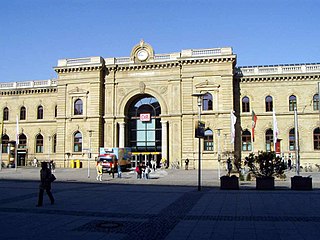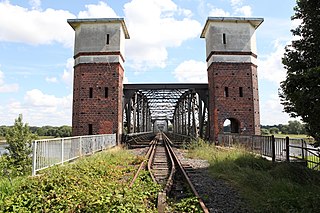
Brandenburg Hauptbahnhof is the main railway station in the town of Brandenburg an der Havel in the German state of Brandenburg. It lies on the Berlin–Magdeburg railway at the junction with the Brandenburg Towns Railway. It has largely lost its former major role for long-distance passenger services and freight traffic, but it continues to serve regional traffic. A water tower on the site of the former freight yard and a plaque commemorating French forced labourers at the station buildings are heritage-listed. The station was renamed Brandenburg Hauptbahnhof at the end of World War II, previously it had been called Brandenburg Rb station. It is classified by Deutsche Bahn as a category 3 station.

The Duchy of Brunswick State Railway was the first state railway in Germany. The first section of its Brunswick–Bad Harzburg railway line between Brunswick and Wolfenbüttel opened on 1 December 1838.

The Magdeburg–Leipzig railway is a double-track, electrified railway in the German states of Saxony-Anhalt and Saxony, connecting Magdeburg via Köthen, Halle and Unna to Leipzig.

The first section of the Berlin–Magdeburg Railway was opened in 1838 as the Berlin-Potsdam Railway and was the first railway line in Prussia. In 1846 it was extended to Magdeburg.

The Brunswick–Magdeburg railway is an 83-kilometre-long (52 mi) German main line railway. It is with the Berlin–Lehrte railway and the Hanover–Berlin high-speed line one of the most important east-west lines between Hanover and Berlin. Important intermediate stations are Königslutter, Helmstedt and Eilsleben.

The Brunswick–Bad Harzburg railway is a 47 km long German main line railway in the northern foothills of the Harz. It is one of the oldest lines in Germany and the first government-owned railway in Germany.

The Berlin–Lehrte railway, known in German as the Lehrter Bahn, is an east-west line running from Berlin via Lehrte to Hanover. Its period as a separate railway extended from its opening in 1871 to the nationalisation of its owner, the Magdeburg-Halberstadt Railway Company on 1 July 1886. The company’s Berlin station, the Lehrter Bahnhof was finally torn down in 1958.

The Berlin–Wrocław railway was a German private railway that connected Berlin and Wrocław. It is one of the oldest lines in Germany, opened between 1842 and 1847 and acquired by the Prussian government in 1852. In 1920, it became part of the German national railways along with the rest of the Prussian state railways.

The Berlin-Blankenheim railway or Wetzlarer Bahn is a railway line in the German states of Berlin, Brandenburg and Saxony-Anhalt. It is a section of the Kanonenbahn between Berlin and Metz, built between 1877 and 1882. Wetzlar used to be an important rail junction on the Kanonenbahn. The Berlin-Blankenheim line originally ran from Berlin, via Bad Belzig, Güsten, Sandersleben to Blankenheim, where a remnant of it still joins the Halle–Kassel line. The Wiesenburg–Güsten section has carried no traffic since 2004 and is now closed. Only the Berlin–Wiesenburg section is electrified. The Sandersleben–Blankenheim section has only a single track, while the remainder of the still-operating parts of the line is duplicated.

The Magdeburg–Thale railway is a predominantly single-track, non-electrified main line railway that connects Thale, in the northern Harz, with Magdeburg, the capital of Saxony-Anhalt. Its eastern section between Magdeburg and Halberstadt was opened in 1843 and it is one of the oldest railways in Germany.

The Jerxheim–Helmstedt railway is a 22 km-long railway line in the south-east of the German state of Lower Saxony that was opened in 1858. It opened up the area south of the Elm hills. Until 8 December 2007, there were passenger services on the route from Brunswick via Wolfenbüttel, Schöppenstedt, Jerxheim and Schöningen to Helmstedt, which was last marketed as the Südelmbahn. The section from Helmstedt to Alversdorf freight yard has since been operated as a connecting line to a facility of the Energy from Waste (EEW) company, formerly half owned by E.ON.
The Wolfenbüttel–Oschersleben railway runs through the border area of the German states of Saxony-Anhalt and Lower Saxony. It was opened in 1843 and was one of the oldest long-distance railways in Germany. All traffic from Berlin and Central Germany ran over it to Hanover and the Ruhr area until the beginning of the 1870s. Afterwards it lost importance, but remained an important line for East-West traffic.

Oebisfelde is a railway station located in Oebisfelde, Germany. The station opened in 1871 and is located on the Berlin-Lehrte Railway. The train services are operated by Deutsche Bahn.

Stendal is a railway station in the town of Stendal, Saxony-Anhalt, Germany. The station lies on the Berlin-Lehrte railway, Hanover–Berlin high-speed railway, Magdeburg-Wittenberge railway, Stendal–Uelzen railway, Stendal-Tangermünde railway and Stendal–Niedergörne railway. It is an important railway hub for regional trains and is also used by Intercity and Intercity-Express (ICE) trains regularly. Until the winter 2012 timetable Stendal station was only by Deutsche Bahn trains. Since December 2012, the station has also been served by some services operated by Ostdeutsche Eisenbahn. It is classified by Deutsche Bahn as a category 3 station.
The Halle–Vienenburg railway is a 123 kilometre long non-electrified main line north of the Harz Mountains in central Germany. It is an important connection between the metropolitan area of Halle (Saale) and the northern Harz mountains. It was opened in several sections between 1862 and 1872 by the Magdeburg–Halberstadt Railway Company and is now maintained by DB Netz except for the disused section between Heudeber-Danstedt and Vienenburg. Since 1996, traffic between Heudeber-Danstedt and Vienenburg has used the railway via Wernigerode running further to the south.
The Holzminden–Scherfede railway was a 49 km long main line from Holzminden to Scherfede in the German state of North Rhine-Westphalia that connected the Altenbeken–Kreiensen railway with the Upper Ruhr Valley Railway. It ran continuously from 1876 to 1984. The most important town on the former line was Beverungen.

Roßlau (Elbe) station is a passenger station and freight yard in the district of Roßlau of the city of Dessau in the German state of Saxony-Anhalt.

Oschersleben (Bode) station is a railway station in the town of Oschersleben (Bode), Saxony-Anhalt, Germany. The station lies on the Magdeburg–Thale railway.
The Schönebeck–Güsten railway is a railway in the German state of Saxony-Anhalt. The line is, with the exception of the Schönebeck (Elbe)–Schönebeck-Salzelmen section, single track and not electrified.



















